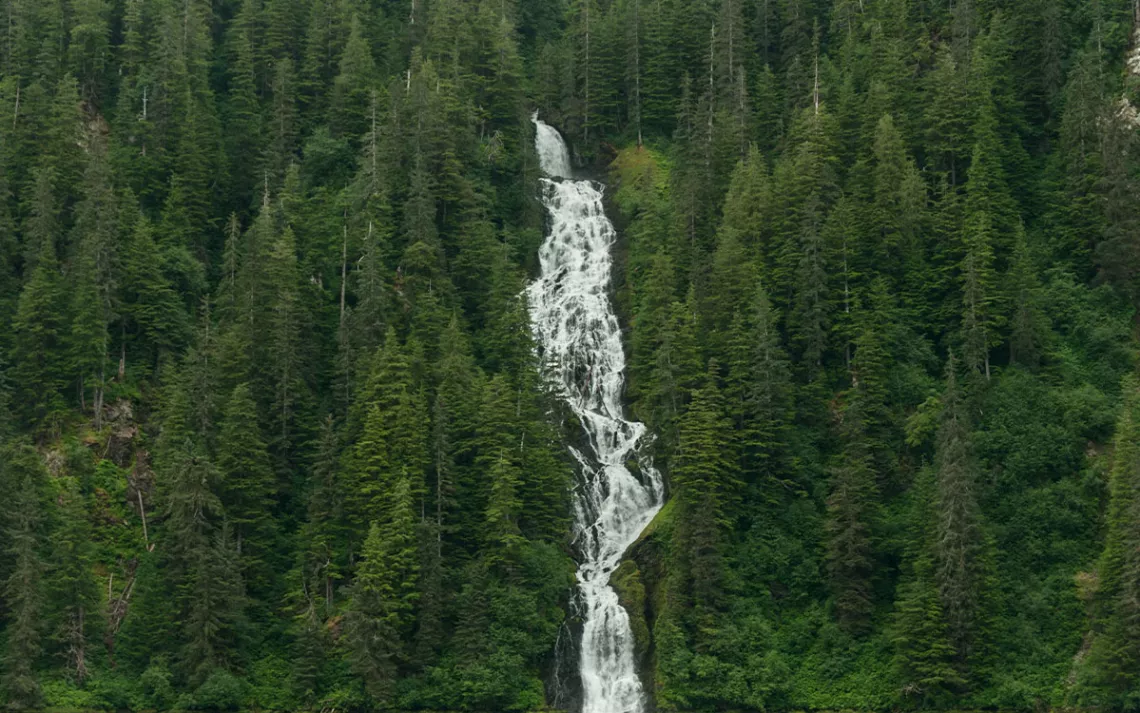New Proposal Hopes to Extend Protections to Old-Growth Forests
Conservation groups welcome the news but lament the lack of measures for mature forests

Waterfall tumbling into Red Bluff Bay, Alaska. | Photo by RONSAN4D/iStock
America’s national forests are one of the best tools available for carbon sequestration. Every year, they store roughly 10 percent of the nation’s greenhouse gas emissions, according to Brenda Mallory, the chair of the White House Council on Environmental Quality—reason enough to protect and strengthen this nature-made carbon capture solution. On December 19, the Biden administration announced plans to do just that with a first-of-its-kind update to the 128 management plans for America’s national forests.
The proposal puts a strong emphasis on conservation by setting a timeline for the creation of standards for old-growth forest cover and then charging land managers with protecting those areas. The move is part of a long-awaited revision meant to curb the loss of mature and old-growth forests, which make up nearly half the US National Forest System’s 193 million acres. The update builds off President Biden’s 2022 executive order directing the Department of Agriculture, which oversees the Forest Service, to inventory and assess the threats to these vital carbon sinks. In its analysis, the agency found that in the last 20 years, fire and insects were the primary threats to older forests. Logging was a lower contributor to forest loss.
“The proposed amendment is intended to do a couple of things,” Randy Moore, the Forest Service chief, said during a press conference announcing the update. “One, it's going to create a consistent approach to manage the old-growth conditions with sufficient distribution, with sufficient abundance, and ecological integrity that can persist over the long term. It's also reaffirming our commitment … to maintain and develop overall conditions … in the context of increased impacts and the overall temperature of forests from climate change, wildfire, and urbanization.”
Federal agencies must also work with tribes to manage forests and create region-specific approaches to forest stewardship. Among the amendments are targets to establish a national plan for forest management, a role for Indigenous knowledge, and a monitoring network so that agencies can assess forest health.
Conservation groups welcomed the rule as a much-needed step in the right direction, but the proposal falls short of environmentalists' initial ask to end logging across old-growth and mature forests completely. “It's a big deal that this is the first time the Forest Service is going to amend all their forest plans at once to project old growth,” Randi Spivak, the director of the Public Lands Policy program at the Center for Biological Diversity, said. “What is of concern is two things. One, at least for now, the proposal leaves out protections for mature trees. On the old-growth front … there's some troublesome language that allows the agencies to still log old growth for various ecological exceptions.”
Mature trees are future old-growth forests, adds Spivak. If the ultimate goal is the conservation and protection of old-growth forests, then these measures should be extended to mature trees as well. For years, conservation groups, including the Center for Biological Diversity and the Sierra Club, have called on the Biden administration to do more to protect mature and old-growth forests. But defining them has been harder to do. Due to the varying development across species, some trees are considered mature well before others. Size also plays a role and varies widely across species. Pinning these details down will be a necessary step in protecting mature and old-growth forests well into the future, which will take time and lots of public input.
Yesterday’s announcement was the initial public notice and represents the beginning of what will likely be a multiyear process to get the new amendments put into place. The Department of Agriculture is currently soliciting comments on the public notice until February. The agency hopes to publish an environmental analysis by the summer, with the aim of publishing a final rule by the beginning of 2025. If the proposal is adopted as is, it can be expected to help federal land managers develop standards and objectives for old-growth forest management.
To help craft a framework for conserving forests, conservation groups are mounting an awareness campaign to urge their members and supporters to weigh in during the two comment periods.
“One of the reasons we got here—here meaning this policy—is because people love our national forests,” Spivak added. “And the Forest Service has been logging them. They continue to log them. Public pressure and public demand have got us to this point. We need to keep it up.” This article has been modified since its original posting.
 The Magazine of The Sierra Club
The Magazine of The Sierra Club



